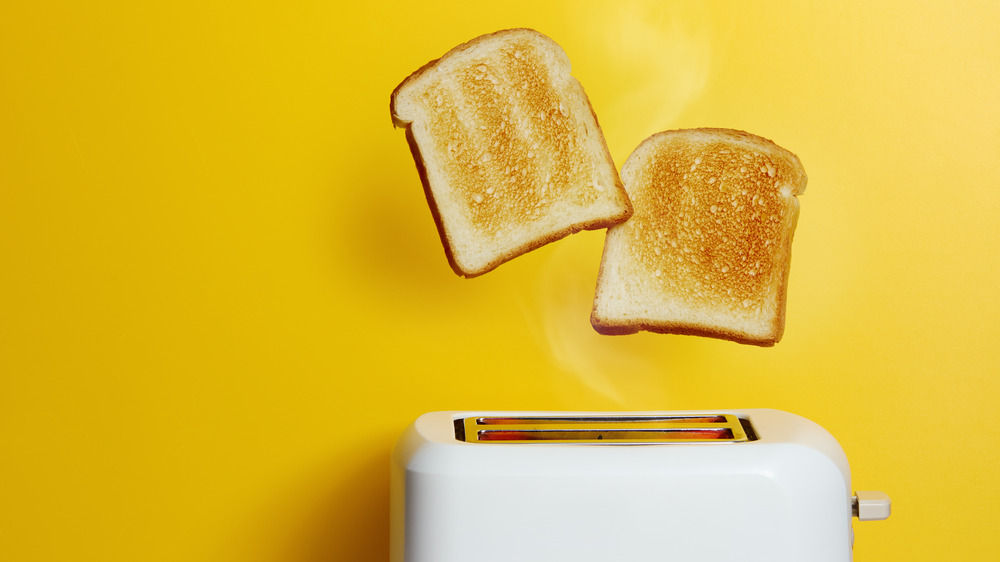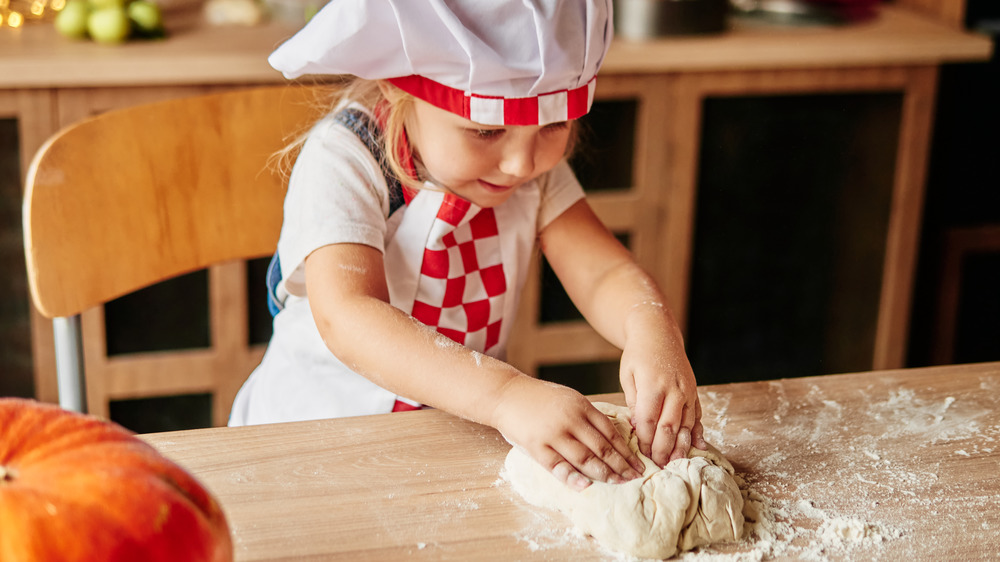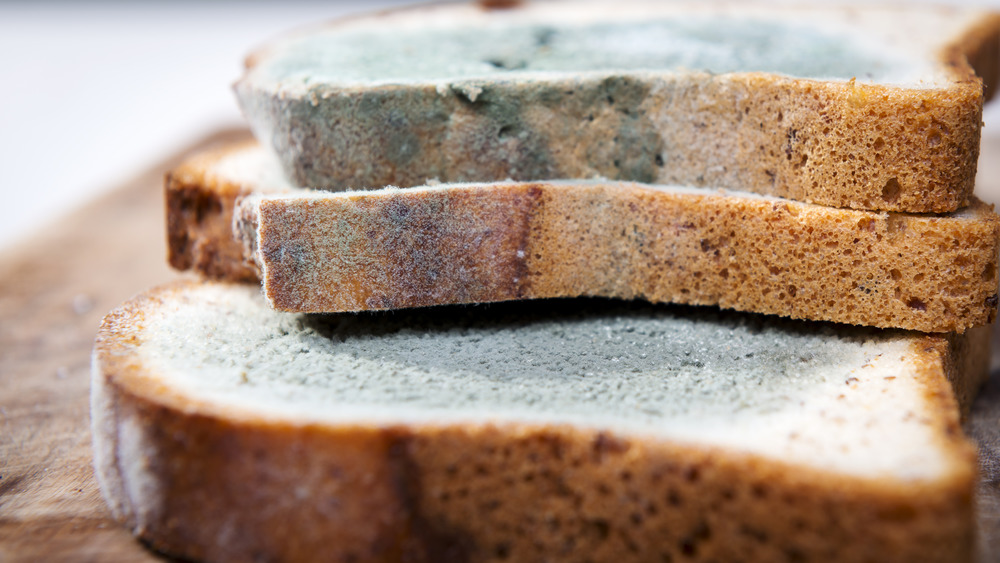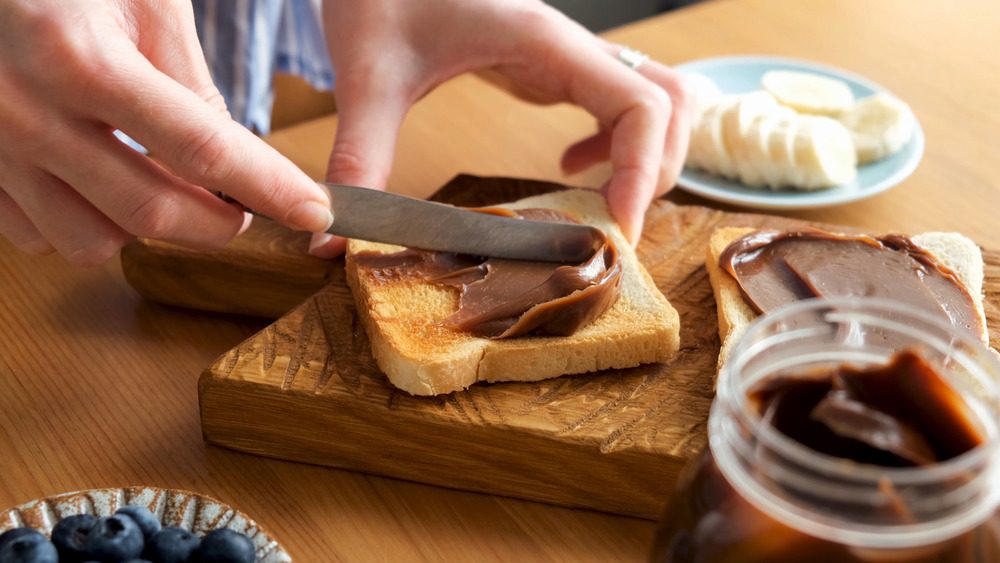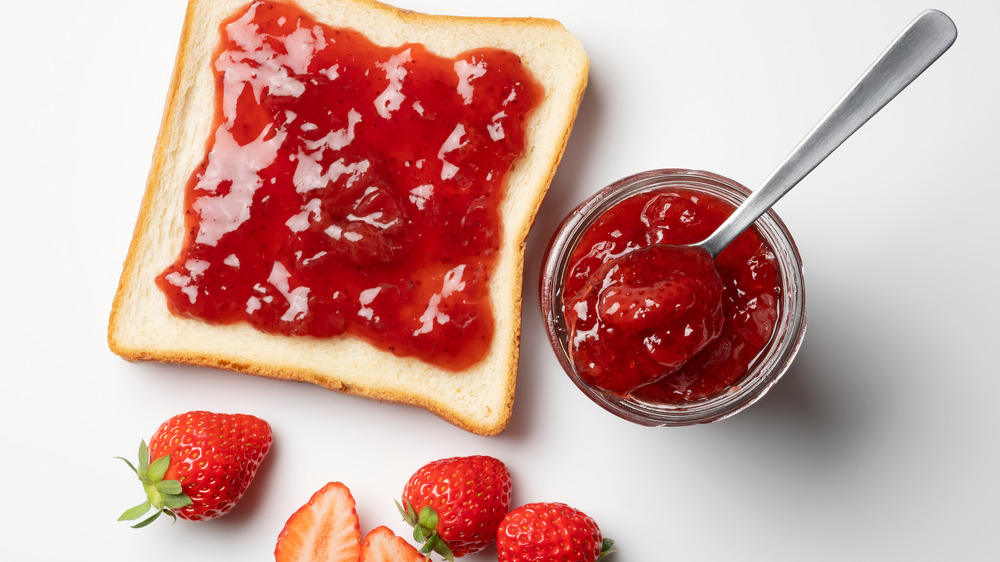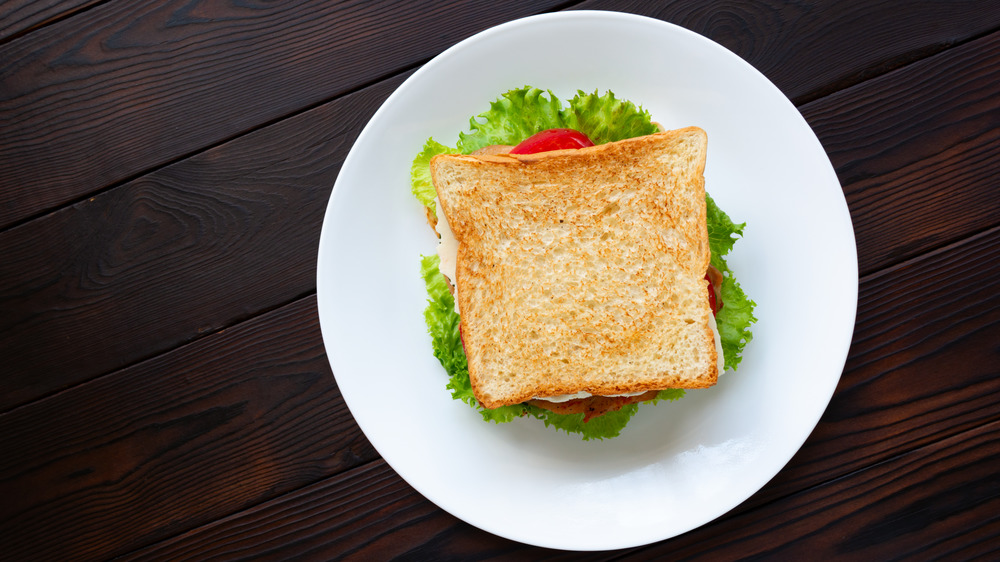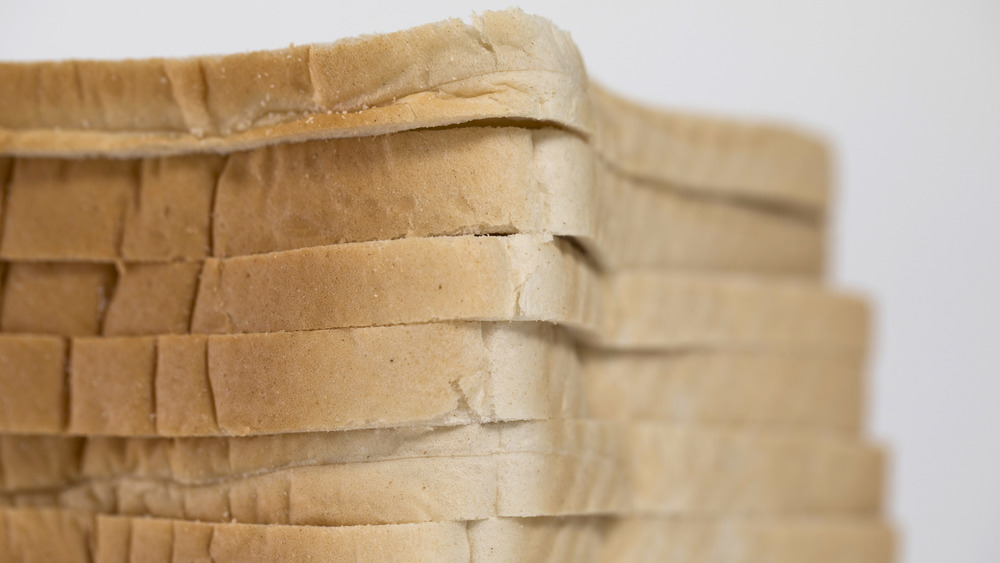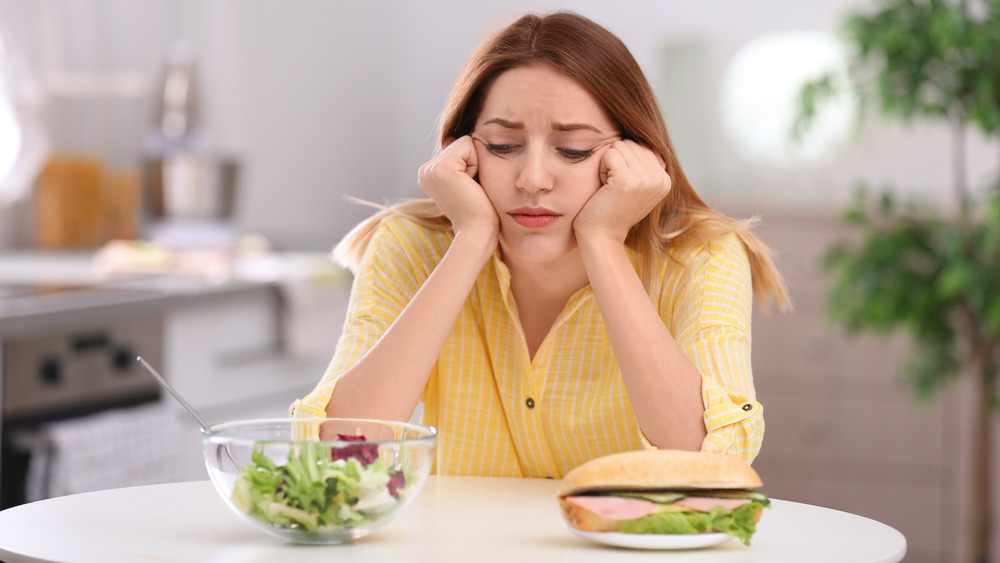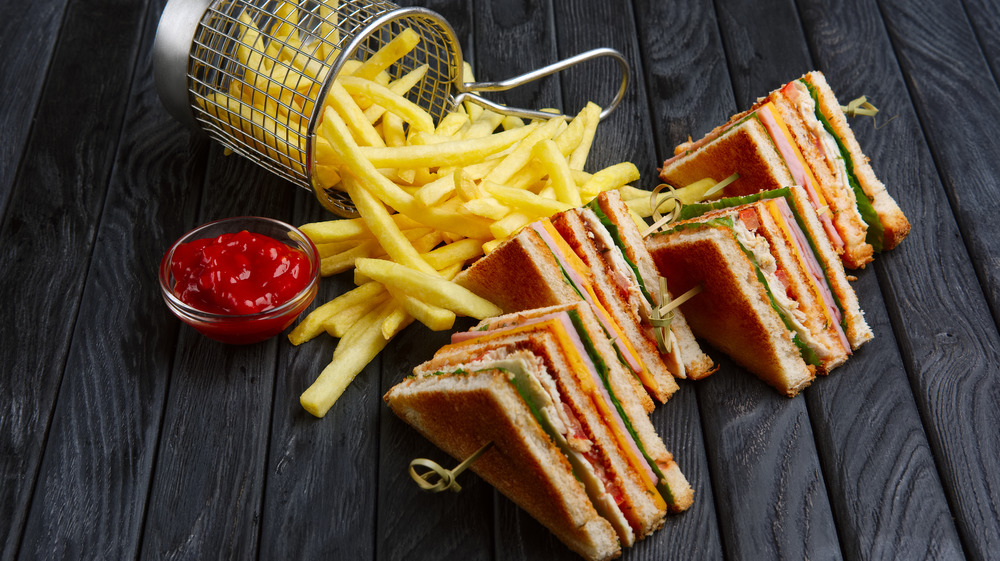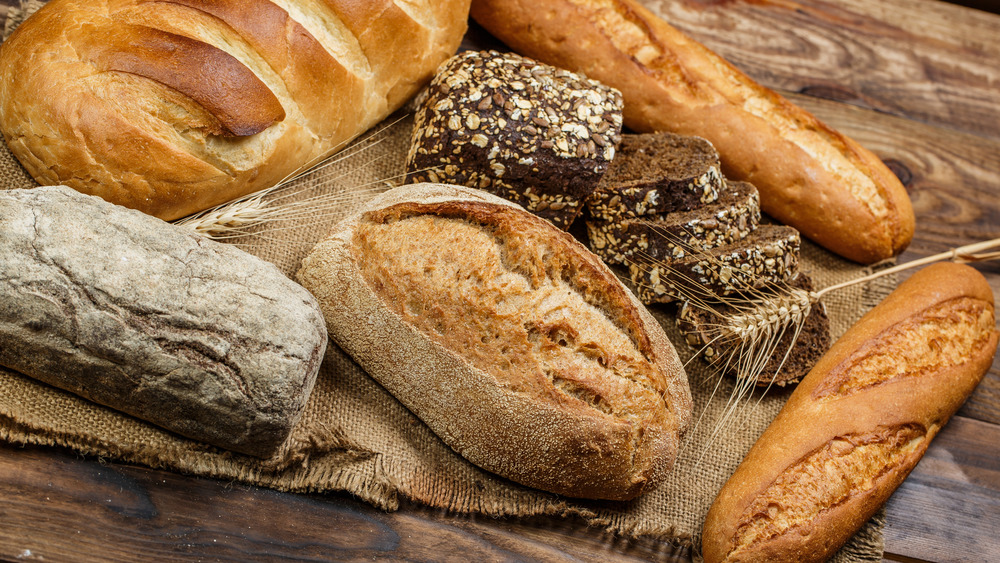Why You Should Never Buy White Bread
Visit the bread aisle in any grocery store — or the bakery, if you're lucky enough to have one of those nearby — and you'll find yourself nearly overwhelmed with choices. Not only are there the old standbys like wheat and rye, but you'll probably discover some more artisanal varieties, too. You might find some sourdough, rustic focaccia, a loaf of ciabatta, and maybe even some old-fashioned soda bread. Those are all delicious, but there's something really compelling about a loaf of plain old white bread, isn't there?
It might be the stuff of childhood Wonderbread and PB&J sandwiches, but you should absolutely resist the urge to reach for the white bread. While you might have heard that nutritionally it's about the worst option out there, there's more to it than that. Did you know, for example, that a white bread habit might be to blame for migraines? No? That's why we're here.
There's more to the story of why you shouldn't be going for the white bread, as it turns out. Don't worry if you still want the occasional indulgence, as this isn't all bad news. If you just can't live without the occasional white bread sandwich, we have a fix for that, too, that surpasses the cheap white bread loaf on the grocery store shelf. Here's why you should never buy white bread.
You can make white bread with far fewer additives
Say you pick up a loaf of white bread at the store. Have you ever actually looked at the ingredients?
A report from IntechOpen examined the additives and preservatives used in commercial bread making. It's shocking stuff. There are "oxidants and reductants" to help strengthen the dough, make it rise more efficiently, and to help encourage the development of gluten. Then, there are "emulsifiers," and a class of ingredients called "hydrocolloids" that also impact things like gluten development and crumb size, which goes on to affect the texture of the bread. That's not even getting into the preservatives that help extend shelf life.
If you opt for baking your own white bread at home, however, the ingredients are much simpler: water, salt, yeast, and flour. That's it!
Leading UK baker Andrew Whitely spoke to the Independent about why this is such a big deal and confirmed that commercial bread-making went through a massive overhaul in about the 1960s. Now, enough time has passed that scientific studies show that this process of making bread easier to commercially produce while also extending shelf life has had a definite impact on nutrition and, in turn, public health. Some further food for thought? Whitely adds that there are some additives that don't even need to be legally disclosed, as they're considered "processing aids," not "ingredients."
Bottom line? Making your own can go a long way in removing unnecessary additives and preservatives from your diet.
Making your white bread instead can improve your mental health
Baking is a science, it's said, and there's no denying the fact that bread can be intimidating to baking newbies. But it doesn't have to be so. Even if you opt for taking some shortcuts, it's been found that baking gives you more than a tasty loaf of fresh bread at the end. It can also give you a not insignificant bit of stress relief.
This fact has a wonderful bit of science to it. Back in 2017, researchers at London's Bethlem Royal Hospital tried something new with a group of their patients: bread-baking (via the Huffington Post). While participating in 2-hour-long baking sessions, they also answered questions about their mental health. It was a small study, but the results were telling. Participants reported that baking bread decreased their anxiety, made them more relaxed, and added a sense of purpose and accomplishment to their day.
According to The Bold Age, this works for a few reasons. The act of kneading and braiding bread can have almost meditative stillness and bring about a sense of mindfulness while allowing a person to focus on the "here and now" of the moment. Then, there's the sense of accomplishment when the loaf comes out of the oven. Seriously, what's better than the smell of freshly baked bread? The bottom line is that you owe yourself the peace, relaxation, and focus that comes with baking bread, not buying it.
White bread can get moldy fast
There are a lot of frustrating things in life, to be certain. One of the little annoyances that's up there is having your heart set on a sandwich or some toast, then finding a bloom of nasty mold on your bread.
Here's where white bread comes in. According to Reference, a general rule of thumb is that the more dense the bread, the slower it will be to host mold. That means your loaf of light and fluffy white bread is going to go moldy much faster than wheat bread, or pretty much any of your other choices. If you're the type that likes to make a loaf last for a bit so you can have those late-night sandwiches, skipping the white just might mean skipping the disappointment of a blue-green slice of bread.
That said, there are a few other things to keep in mind. A commercial loaf will last longer than a homemade one. The trade-off is the inclusion of all those preservatives, and let's be honest: does a loaf of homemade bread last long enough to even think about molding? We didn't think so. Regardless of what kind of bread we're talking about, your best bet to keep bread fresh is to freeze any remaining bits and then reheat the slices in an oven as you need them. And, no, don't put it in the fridge. That can dry out your bread and make it go stale even faster.
White bread contains a chemical that could trigger migraines
Migraine sufferers will know the telltale signs that one is lurking just around the corner, waiting to turn into full-blown agony. The Mayo Clinic says that while there's a lot about migraines that remains a mystery even to neurologists, doctors do know that different people might be susceptible to migraines when they're exposed to certain individual triggers. Common ones include bright lights, specific smells, and changes in the weather, along with certain food additives.
And it's the last one we're interested in for our conversation about white bread. VeryWellFit says that one of the most common preservatives used in white bread is an additive called calcium propionate. While it has been thoroughly vetted by the US Food and Drug Administration and determined to be GRAS (Generally Recognized As Safe), there is some evidence that it can be a migraine trigger in some people. Healthline agrees, saying that instances of severe headaches caused by this particular additive are rare. However, if that little bit of knowledge can save even one person from suffering through migraines triggered by something in their white bread, it's worth mentioning.
White bread could make you more likely to overindulge
Stress- or boredom-related eating can definitely sabotage the most well-intentioned meal plan. But what about those times you eat because you're, you know, actually hungry, only to find you're ravenous again just an hour or so later? You're not alone. In fact, it might have something to do with your choice of foods.
Dr. Sue Decotiis, MD, is an internist and specialist in weight loss. She says (via Health) that eating white bread has a different effect on your body than other types of bread. White flour lacks the bran that's found in other types of flour and bread. Bran has a high fiber content. That fiber is important not just for digestion and keeping everything moving comfortably, digestively speaking, but it's also what helps make you feel full after you've eaten. Time adds that there's a double whammy going on here, as white bread is a highly processed food that also interferes with your body's ability to normalize your blood sugar levels. This ultimately leaves you still craving more food, even though you've just eaten.
It might seem like a small thing, but one study done in Spain seems to show that it can have a huge impact. When researchers looked at 9,000 participants, they found that those who favored white bread over other types (and ate it on a daily basis) were about 40 percent more likely to struggle with their weight (via UPI).
White bread can mess with your blood sugar
When Erin Palinski-Wade, RD, spoke with Everyday Health about the downsides of white bread, she gave a very good reason that people might want to skip it, particularly if they're concerned about the potential of developing diabetes.
Palinski-Wade says that when white flour is stripped of things like protein and fiber, it — and the products made with it — are digested much faster than counterparts made with multi-grain flours. That, in turn, sends a person's blood sugar skyrocketing. Anyone who's felt the roller coaster ride that up-and-down blood sugar can send you on knows what comes next: a crash.
That's a short-term reason to skip a white bread sandwich, but what about the long-term consequences of consuming loads of white bread? Palinski-Wade says that the imbalance in blood sugar caused by white bread makes the body's insulin production go into overdrive. Over time, that increases a person's insulin resistance and, perhaps most alarmingly, their likelihood of developing type 2 diabetes.
White bread could have a ton of sodium
Sodium intake is, on the whole, a huge problem in the United States. Healthline says that, on average, Americans get about 3400 mg of sodium in their diet every day, while the recommendation is less than 2300 mg. (In an ideal world, experts say, that should actually be about 1500 mg.) While white bread doesn't seem like an obvious suspect when it comes to high-sodium foods, the Center for Science in the Public Interest says that some kinds can contain a shocking amount of salt. For example, they found that a single slice of Pepperidge Farm's Farmhouse Hearty White Bread had the same amount of salt as 21 potato chips — and that's after the company revamped their recipes to cut down on the sodium.
Vox took a look at other reports that examined other kinds of white bread for their salt content and found some (like rosemary focaccia from a bakery in Canada) that contained a higher percentage of salt than actual saltwater. Then, there's the popular South African white bread that had a higher single-serving salt content than four servings of McDonald's fries. As a general rule, they found that white bread did tend to have more salt than other types of bread, which we can learn two things from. Not only is it better to skip the white bread if you're concerned about your salt, but it's important to read labels, too.
White bread is extremely low in fiber
Healthline says that there are some times that a low-fiber diet might be prescribed by a person's doctor. That's usually in cases of an illness like irritable bowel syndrome or ulcerative colitis, which can be aggravated by the presence of a lot of fiber. It's also often prescribed temporarily for someone undergoing a colonoscopy, but they also say that low-fiber diets aren't meant to be followed for the long-term.
A low-fiber diet can be incredibly limiting, and one of the things that are recommended is white bread, (along with other white flour-based foods like pasta. White bread isn't just kind of low in fiber, too. Indeed, it's so low in fiber that New Food has reported on work undertaken at the John Innes Centre and Rothamsted Research to increase the fiber found in white bread. Researchers hope to make bread more accessible and healthier for the general public.
Until high-fiber white bread hits the market, reaching for the white bread might cause some of the unwanted consequences of a low-fiber diet, assuming your doctor hasn't directed you away from high-fiber stuff in the first place. According to Eating Well, those consequences include things like a higher risk of developing cardiovascular disease and chronic inflammation. Low-fiber foods like white bread also hold the potential to make you more susceptible to illness by sabotaging your immune system.
There's a link between white bread and depression
First, a bit of a disclaimer: the discovery of a link between two things doesn't necessarily mean that one causes the other. Correlation does not imply causation, as statistics professors and internet smart-alecks alike will tell you, according to Slate.
That said, here's some food for thought. In 2015, ScienceAlert reported on a study that found a link between refined carbohydrates — like those found in white bread and pasta — and depression. The research was done by Columbia University Medical Center. When Columbia researchers cross-referenced the diets of 70,000 post-menopausal women with instances of mental health issues, they found that the more refined carbs and added sugar that were consumed by participants, the more likely the women were to report that they were also suffering from depression.
While much more research is definitely needed to figure out what's going on here, scientists did have some ideas on what this connection might be. Researchers suggested that, when these foods are eaten on a regular basis, the insulin spike and resulting crash that comes afterward might contribute to feelings of chronic exhaustion and mood swings. That, in turn, may contribute to an overall feeling of ill health, which might explain the link to depression and lowered moods.
White bread is surprisingly bad for your teeth
White bread doesn't just taste different than, say, rye, it has a much different texture as well. Imagine biting into a slice of white bread. It kind of smushes, right? Many of you may have also noticed that the bread gets almost immediately sticky, to the point where the bread bits adhere to your teeth.
According to Dentistry with Smiles, that happens because of the high percentage of refined carbohydrates present in that slice of white bread. When you eat it, the sugars and bacteria in your saliva start to break the refined carbs down immediately. Those new compounds stick to your teeth. Anyone who's ever had a peanut butter and jelly sandwich on white bread can attest to this, as it's not just the peanut butter and sugary jelly that makes this particular sandwich so sticky.
The Center for Implants & General Dentistry adds that the compounds left behind by this interaction are highly acidic. They are so acidic, in fact, that they can damage your all-important tooth enamel. The result is a higher instance of tooth decay and even gum disease. So, when it comes to dentists' recommendations for less painful visits, it includes skipping the regular dose of white bread every day.
Dependence on white bread can cause some serious issues
"But," some parents might be saying, "my child is a picky eater who only likes white bread. That's ok, right? It'll probably change ... right?"
Perhaps not. For the skeptical, consider this cautionary tale. In 2019, the BBC reported on the extraordinary case of a Bristol teenager who couldn't shake his devotion to white bread. They say that he had been a picky eater from childhood who cited the texture of food as the reason he never branched out into other meals. Said teen only ate fries, white bread, Pringles, and the odd slice of ham. At 14, he had been prescribed a regimen of supplements but didn't stick to it. By 17, he had developed permanent blindness and was suffering from severe bone loss. Doctors used the case to caution parents of picky eaters. They admitted that it was an extreme case, but it was also an example of just how far a person's health can deteriorate if they rely only on a few, nutrient-poor foods for their entire diet.
In other words? Catering to a picky eater who only demands the white bread might just lead to a lifetime of compromised health. It may be more work for you now, beleaguered parent, but encouraging your kid to try new and more nutritious foods will benefit them in the long run. Maybe follow Chrissy Teigen's picky eater strategy if you need some hints.
White bread being shady is nothing new
It might seem like all the unnerving discoveries about white bread are a modern thing, but let's get a little historical context. Look back to the 19th century, which wasn't all that long ago, and you'll find that white bread was always a bit dodgy. Of course, Victorian folks had different reasons for taking a second or third look at their loaf of white bread.
According to the BBC, Victorian-era bakers often struggled with something that's unfortunately pretty widespread throughout the human race: greed. To that end, unscrupulous bakers replaced flour with other cheaper and heavier ingredients like plaster, chalk, and even alum, an ingredient better suited to detergent. Vassar College's Professor Anthony S. Wohl says (via Victorian Web) that the trend had caught on in such force that, by the 1870s, health and social reformers had proved that about half of all the bread contained high amounts of alum.
This wasn't just dishonest. These corner-cutting baking practices were downright dangerous and, in some cases, deadly. Families who relied on bread as a major part of their diet were soon facing malnutrition and chronic gastrointestinal distress. This could prove to be fatal, especially for the children who ate the adulterated bread. Hillbrush says that the widespread practices of contaminating food with ingredients that were often neither healthy nor actually edible led to the establishment of legislation governing things like food safety and labeling. White bread, it appears, has a pretty rough pedigree already.
